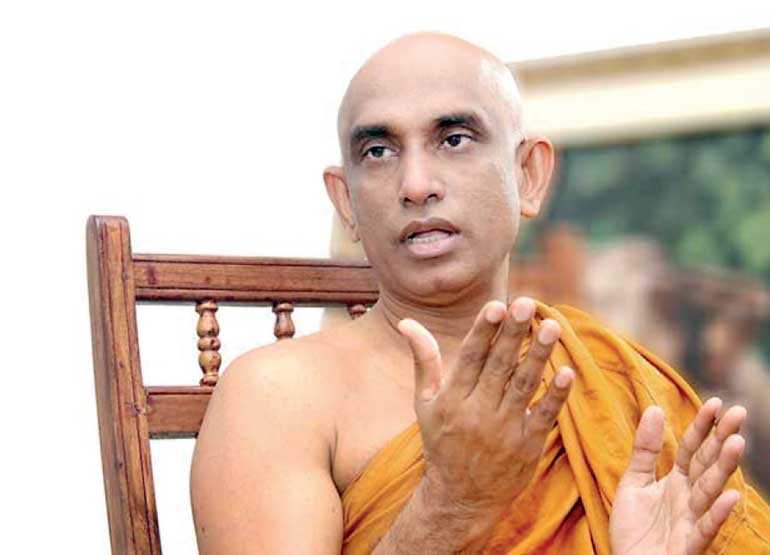Thursday Apr 03, 2025
Thursday Apr 03, 2025
Thursday, 23 January 2020 00:00 - - {{hitsCtrl.values.hits}}

If Rathana Thero wants to uphold Sinhala Buddhist culture, what he should do is to repeal the Marriage Registrations Ordinance 19 of 1907 and make the Marriage and Divorce (Kandyan) Act 44 of 1952 the Common law of Sri Lanka in relation to marriage and divorce
There were four bills presented by private members to the Parliament on 8 January (one bill is to be presented) which were already advertised in the gazette. They were to repeal the Kandyan Marriage and Divorce Act No. 44 of 1952; to repeal the Muslim Marriage and Divorce Act No. 13 of 1951; to amend the Marriages (General) Ordinance No. 19 of 1907; to amend the Marriages Registration Ordinance; and to introduce a minimum age of marriage in Sri Lanka. The first three were/will be presented to the Parliament by Ven. Athuraliye Rathana Thero MP and the other two were presented by MP Dr. Thusitha Wijemanna.
In Sri Lanka the Common law applicable to marriage and divorce is based on the Roman Dutch law. This Common law is in the Marriages (General) Ordinance No. 19 of 1907. In addition to that there is Kandyan Marriage and Divorce Act No. 44 of 1952 applicable for the people living in the Kandyan Districts. For the Muslims in Sri Lanka the applicable law is Muslim Marriage and Divorce Act No. 13 of 1951 (MMDA). The intention of the proposed amendments is to make Roman Dutch law the only law applicable to marriage and divorce in Sri Lanka and to make the minimum age for marriage 18 years.

Minimum age of marriage
According to Section 23 of MMDA, a marriage contracted by a Muslim girl who has not attained the age of 12 shall not be registered under this Act unless the Quazi for the area in which the girl resides has, after such inquiry as he may deem necessary, authorised the registration of marriage. According to Section 15 of Marriage Registrations Ordinance 19 of 1907, lawful age of marriage, in relation to a male was 16 years and in relation to a female was 12 years and if a female was a daughter of European or Burgher parents, the minimum age was 14 years. It was amended by Act No. 18 of 1995 raising the minimum age of both male and female to 18 years irrespective of the ethnicity.
According to Section 66 of the Marriage and Divorce (Kandyan) Act 44 of 1952, lawful age of marriage, in relation to a male was 16 years and in relation to a female was 12 years. This was amended by Act No. 19 of 1995 raising the minimum age of both male and female to 18 years.
Therefore, not only the Muslims but also all the others thought in the same line in relation to the minimum age of the marriage. All the others, other than Muslims, changed it. The Muslim community should also fall in line with the changing environment.
Kandyan law
At the time of the arrival of the Western invaders to Sri Lanka, the marriage and divorce practices and the relevant law were very liberal.
According to Niti Nighanduwa which was believed to be written between 1769 and 1815 at Senkadagalapura, either the husband or the wife can disengage from the marriage bond. There were no barriers for disengagement. However, there were consequences.
At the marriage the ownership of the properties of the husband and wife were kept separately with them. The wealth earned by both would be divided equally at the time of disengagement. If the disengagement of the marriage is executed by one party, then that party does not have any right of the assets of the other party.
Niti Nighanduwa gives a detailed account of the family law prevalent during that time. Liberal nature of that law was confirmed by Robert Knox in his book.
According to Section 32, the dissolution of the marriage can be granted on any of the following grounds:
These provisions although liberal tried to impose conditions to the provisions in Niti Nighanduwa.
Roman Dutch law
Colonial masters imposed a different law based on Roman Dutch law on marriages and divorces for the people who lived outside of the Kandyan districts. These people were influenced and “cultured” by their colonial masters over centuries. Marriage was viewed as a sacred act by the Christians.
Christian marriage is a union between a man and a woman, instituted and ordained by God, for the lifelong relationship between one man as husband and one woman as wife. This expectation of the lifelong relationship was being reflected in the Roman Dutch divorce law.
Law makers should never interfere with Muslim law which is based on their cultural heritage. People should oppose the Muslim law if there are any violations of human rights or any discrimination against the weak in the name of such culture and laws. If Rathana Thero wants to have a one law for marriage and divorce, he should draft a new law applicable to current society eliminating the destructive aspects of Roman Dutch law
According to Section 19 of Marriage Registrations Ordinance 19 of 1907, no marriage shall be dissolved during the lifetime of the parties except by judgement of divorce a vinculo matrimonii pronounced in some competent court. Such judgement shall be founded either on the ground of adultery subsequent to marriage or of malicious desertion or of incurable impotency at the time of such marriage.
This is legalisation of the will of the God. This conservative law was based on the Victorian culture that prevailed in Europe at that time. Present divorce laws in the Europe are very liberal and are in line of the Kandyan law. Present Sinhala society is also in the process of absorbing old Kandyan values of marriages and divorces.
Rathana Thero and his ideological group of Sinhala Buddhism are unknowingly trying to uphold a law which is based on colonial Christian values while trying to abandon a law which is based on Sinhala Buddhist heritage and the values. What an irony.
If Rathana Thero wants to uphold Sinhala Buddhist culture, what he should do is to repeal the Marriage Registrations Ordinance 19 of 1907 and make the Marriage and Divorce (Kandyan) Act 44 of 1952 the Common law of Sri Lanka in relation to marriage and divorce.
Muslim law
In Sri Lanka the amendments to MMDA were discussed. Muslim women have been agitating against the provisions of the Act for more than 30 years. Successive governments appointed different committees. A committee headed by Justice Saleem Marsoof was appointed in 2009 and the report was issued in July 2019. Although Muslim Parliamentarians agreed to 14 recommendations, it is reported that All Ceylon Jamiyyathul Ulama (ACJU) was against these recommendations.
Muslim women request that the minimum age of marriage for all Muslims must be 18 years without any exceptions; women should be eligible to be appointed as Quazis, as Members of the Board of Quazis, Marriage Registrars, and Assessors (jurors); the MMDA must apply uniformly to all Muslims without causing disadvantage to persons based on sect or madhab; signature or thumbprint of bride and groom is mandatory in all official marriage documentation to signify consent; registration should be required for legal validity of marriage; adult Muslim women are entitled to equal autonomy and need not require ‘permission’ by law of any male relative or Quazi to enter into a marriage; Talaaq (divorce) and Faskh (annulment) rights between women and men must be equal; procedures for divorce initiated by men and women must be the same, including appeal process; and to revise the Quazi court system to ensure a competent system with improved access to justice for women and men.
These are very reasonable demands. Civil society in Sri Lanka is also opposing to MMDA in the same lines namely discrimination against children and women. However nationalistic Sinhala Buddhists are opposed to MMDA on the grounds that Sri Lanka should have only one law and there should not be different laws for different ethnicities.
Therefore, the opposition to MMDA by the Muslim women and civil society and the opposition to the same by the nationalistic Sinhala Buddhists are coming from different reasons and from different backgrounds. The latter, although comes with the frontline of ‘one country, one law’ in the pretext of unification, is in fact targeting discrimination on the Muslims.
Conclusion
Law reflects the culture of the people. Muslims in Sri Lanka over centuries preserved their cultural identity while mixing with the other communities.
In her book ‘The Muslims of Sri Lanka – One Thousand Years of Ethnic Harmony, 900-1915,’ Lorna Dewaraja stated as follows: “...This is striking example of the policy of live-and-let-live characteristic of Sinhala society at that time. Muslims, Hindus, and Buddhists were voluntary participants in the festivities of the Embekke devala and none of those groups lost their cultural identity in the process.”
Law makers should never interfere with Muslim law which is based on their cultural heritage. People should oppose the Muslim law if there are any violations of human rights or any discrimination against the weak in the name of such culture and laws. If Rathana Thero wants to have a one law for marriage and divorce, he should draft a new law applicable to current society eliminating the destructive aspects of Roman Dutch law.
Discover Kapruka, the leading online shopping platform in Sri Lanka, where you can conveniently send Gifts and Flowers to your loved ones for any event including Valentine ’s Day. Explore a wide range of popular Shopping Categories on Kapruka, including Toys, Groceries, Electronics, Birthday Cakes, Fruits, Chocolates, Flower Bouquets, Clothing, Watches, Lingerie, Gift Sets and Jewellery. Also if you’re interested in selling with Kapruka, Partner Central by Kapruka is the best solution to start with. Moreover, through Kapruka Global Shop, you can also enjoy the convenience of purchasing products from renowned platforms like Amazon and eBay and have them delivered to Sri Lanka.
Discover Kapruka, the leading online shopping platform in Sri Lanka, where you can conveniently send Gifts and Flowers to your loved ones for any event including Valentine ’s Day. Explore a wide range of popular Shopping Categories on Kapruka, including Toys, Groceries, Electronics, Birthday Cakes, Fruits, Chocolates, Flower Bouquets, Clothing, Watches, Lingerie, Gift Sets and Jewellery. Also if you’re interested in selling with Kapruka, Partner Central by Kapruka is the best solution to start with. Moreover, through Kapruka Global Shop, you can also enjoy the convenience of purchasing products from renowned platforms like Amazon and eBay and have them delivered to Sri Lanka.